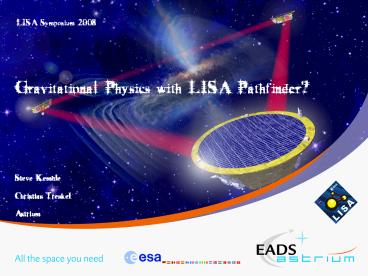Gravitational Physics with LISA Pathfinder PowerPoint PPT Presentation
1 / 17
Title: Gravitational Physics with LISA Pathfinder
1
Gravitational Physics with LISA Pathfinder?
- Steve Kemble
- Christian Trenkel
- Astrium
2
Overview
- Motivation
- Assumptions and Constraints
- Method
- Results
- Conclusions
- Future Work
3
Motivation
- LISA Pathfinder is potentially a fantastic tool
for gravitational experiments in the Solar
System - DC free-fall quality of 10-9ms-2 (DC
self-gravity) - Free-fall quality of 10-13ms-2 /vHz around 1mHz
- Gravity gradiometer of sensitivity 10-14/s-2/vHz
- see ESA-SCI(2007)1 LISA Pathfinder Einsteins
Geodesic Explorer The Science Case for LISA
Pathfinder
- Investigate whether it can be used to test
- MOdified Newtonian Dynamics (MOND)
- Flyby anomaly
4
MOND
- Newtonian Dynamics within composite system is
modified when centre-of-mass acceleration of
system is a0lt10-10ms-2 (Milgrom 1983) - Phenomenological formula with no underlying
theory - Extremely successful in describing rotation
curves of galaxies without the need for Dark
Matter - Relativistic theory (TeVeS) developed with
non-relativistic MOND limit (Bekenstein 2004) - Prospects for Solar System tests poor eg solar
acceleration at 1AU approx. 6x10-3ms-2 - But Saddle Points may offer opportunities
(Bekenstein Magueijo 2006)
5
MOND
- MOND bubbles Regions of space around saddle
points where MOND effects might be measureable.
Neglecting bodies other than Sun and Earth - Centered around Earth Sun saddle point
(259000km distance from Earth along Earth Sun
line) - 766km semi-major axis
- 383km semi-minor axis
6
MOND
- Quantitative prediction of gravity gradient
anomalies (Bekenstein Magueijo 2006) - At bubble boundary anomalous gravity gradients
- d(dg/dr) 10-13s-2
- against expected Newtonian gradients (Earth)
4x10-11s-2 - Inside bubble
- gt 10-13s-2 (even gt Newtonian in very small
core region) - Outside bubble
- d(dg/dr) a1/r2
- ? With a gradiometer sensitivity of 10-14/s-2/vHz
around 1mHz, LPF could detect the MOND anomalies
inside / close to the bubble!
7
Flyby Anomaly
- Observation Orbital energy of satellites before
and after Earth fly-bys changes six fly-bys
studied (Anderson 2008) - V8 between 4km/s and 16km/s
- Closest approach altitudes between 300km and
2500km - Large effect with SNR up to 103
- Anomaly present in both Doppler and ranging data
- Empirical expression describing energy change as
function of incoming and outgoing geocentric
latitudes - No known explanation
8
Flyby Anomaly
- Earth flybys conducted with LPF would have the
following properties - Flybys will not have V8 gt 0, but V8 lt 0 (weakly
bound) - For low altitude, fast flybys (1000s 10000s)
could have free-fall quality around single test
mass significantly better than DC value 10-9ms-2 - Low ( 1000km) and high (gt 10000km) altitude
flybys could be compared - Choice of geocentric latitudes possible to
maximise effect - ? The effect could in principle be studied more
systematically
9
Assumptions and Constraints
- Challenge can we use LPF to explore the above
effects by executing adequate trajectory
manoeuvres? - Allowed modifications to as is LPF Hardware
- NONE
- Allowed interference with nominal LPF Mission
- NONE
- ? Only option explore ways to use LPF after its
nominal mission has finished. Only resource then
residual micropropulsion authority. - LPF micropropulsion dV budget at the end of
nominal mission - FEEP estimates vary between 6m/s and 15m/s
- No assumptions about DRS thrusters
10
Method
- Use a single dV manoeuvre of lt1m/s from nominal
halo orbit around L1 certainly conservative - Propagate LPF orbit including gravitational
effects of Sun, Earth and Moon SRP not included - Use standard orbit propagation software for this
initial assessment - Estimated orbit propagation error for long
propagations of order 10000km - Maximum propagation time 2 years
- Goal proof of principle rather than exact
predictions
11
Results
- First attempt use single 1m/s manoeuvre, applied
at 28 to the Sun-Earth line, and vary only the
L1 orbit departure time
Earth
Earth-Sun SP
Departure time steps 5 days
12
Results
- Fastest result of simple search solution
missing Earth-Sun SP by 30000km after transfer
time 340days
13
Results
- Coarse 2 parameter search L1 orbit departure
time and dV magnitude (always lt1m/s)
Fine-tuning of parameters allows to find miss
distances lt10000km
14
Results
- Selected sample trajectory miss distance 5000km
after 480 days, using single dV of 0.87m/s
15
Results
- Intriguing possibility use Moon flyby to inject
into near circular orbit potential chance for
repeat experiments??
Earth
Earth-Sun SP
16
Conclusions
- A simple parameter search shows that a single dV
manoeuvre of lt 1m/s, starting from the LPF halo
orbit around L1, is sufficient to reach the MOND
bubble around the Earth-Sun Saddle Point - Standard orbit propagation software unable to
pinpoint Saddle Point miss distance to less than
10000km but proof of principle has been
obtained - Transfer times to target region shorter than one
year have been found - A Lunar gravity assist may offer the
opportunity for a repeat experiment unlikely
but not impossible - Typical LPF speeds around SP are a few km/s
anomalous gradients inside the deep MOND regime
bubble will be experienced for between 200s and
1000s ideal - Multiple Earth flybys are generated as a
by-product not further investigated
17
Future Work
- Develop customised orbit propagation software for
high precision propagation - Include SRP effect and other gravitational
perturbations - Include change of position and shape of target
region as a function of Moon / Jupiter position - Consolidate micropropulsion budgets (inc DRS) and
consider larger / additional manoeuvres - Consider implications on LPF SC / Payload
operations - SC navigation accuracy
- Need for PM re-caging / grabbing
- Life-time issues
- Carry out search for optimum LPF trajectory /
manoeuvres - We would like to do all this officially!

